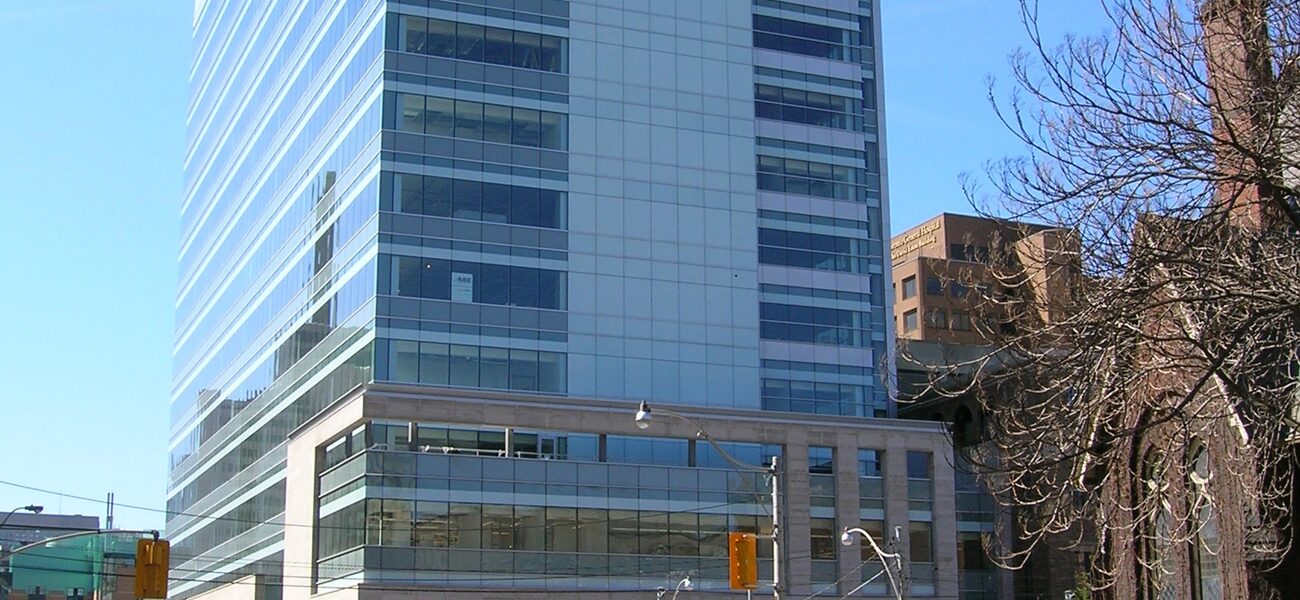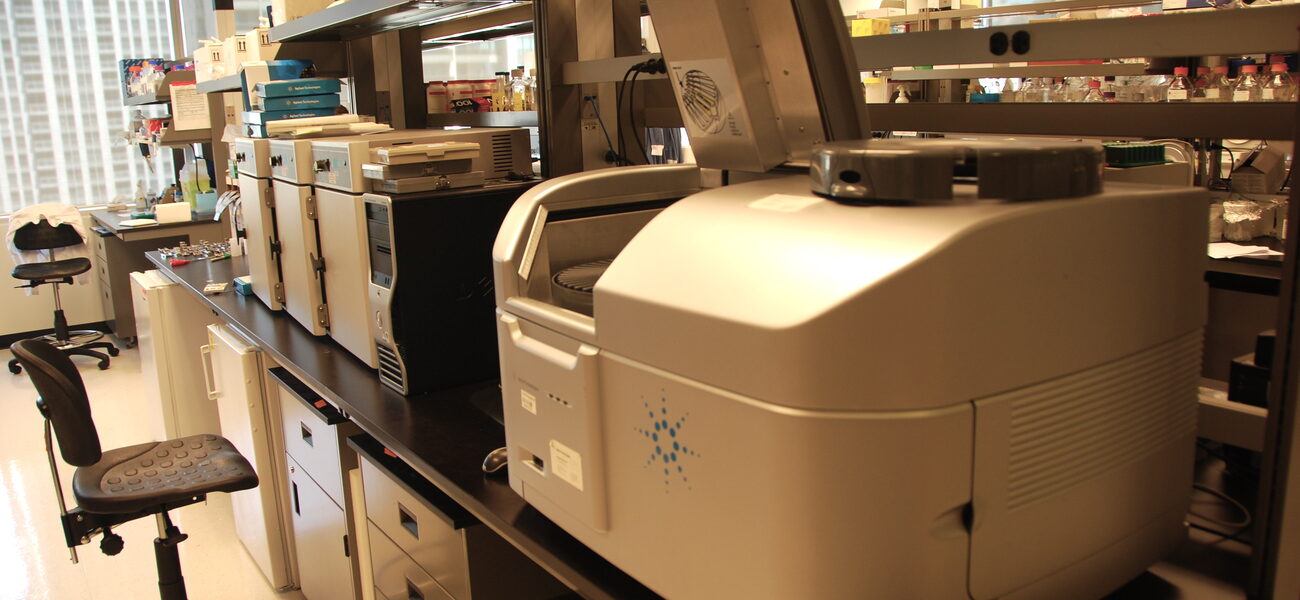In an era of shrinking research funding and growing reliance on complex technologies, a centralized core model resolves a host of issues faced by sizable institutions like University Health Network (UHN) in Toronto, Canada’s largest research hospital.
Specialized biomedical research core facilities account for nearly 70,000 sf, or 7 percent, of the 1 million sf dedicated to research at UHN. Dispersed among several buildings, the cross-platform cores house an array of complex instruments, from spinning disc confocal microscopes to a laser scanning cytometer, and deliver advanced services like deep gene sequencing and microarray imaging and quantification.
An additional 114,620 sf is dedicated to more conventional fundamental cores—vivariums, sterilization, and tissue culture/media—providing services that are essential to biomedical research.
Both types of cores serve the entire UHN portfolio, which is substantial. Under the UHN nameplate are four hospitals (Toronto Western, Toronto General, Princess Margaret, and Toronto Rehab) and five research institutes (Ontario Cancer Institute, Toronto General Research Institute, TECHNA, Toronto Western Research Institute, and Toronto Rehabilitation Institute). All together, these entities represent $344 million worth of research activity, with a staff approaching 4,000.
“Our core facilities have multiple different types of equipment,” says Ian McDermott, UHN’s senior director of research facility planning and safety. “There is no single lab that could afford the expense of having all the different types of technology available today.”
Beyond overcoming economic constraints, UHN’s core scheme offers a number of other benefits, from providing researchers with expert technology support and data interpretation to increasing equipment utilization, fostering collaboration, and enhancing recruitment. It also responds to location challenges, paves the path to external partnerships, and lowers operating costs.
Core Definition
Blending elements from several sources, including the National Institutes of Health and Canadian institutions, UHN has defined research core facilities as “centralized and shared resources that offer specialized instrumentation and/or services that are required by multiple investigators.”
McDermott is keen to emphasize the distinction between a research core as a central resource that is shared across research platforms, as opposed to a more conventional shared resource that might be utilized by two or three labs conducting similar investigations.
“There is a significant difference,” he says. “Research cores house incredibly expensive and hard-to-use technologies in a centralized location and make these services available to multiple organizations.”
To expand on the difference, McDermott cites UHN’s microscopy core, the Advanced Optical Microscopy Facility (AOMF), which houses not only highly specialized microscopes but also an expert staff who manage the instruments and teach scientists how to use them—to the point of helping decide which experimental path to pursue.
“AOMF is open to anyone who needs to use its equipment,” he says.
In contrast, a shared resource like a tissue culture room would typically serve just a few research teams. Individual researchers might use the same centrifuge and microscope, but they would still have their own containment hoods and incubators.
“A tissue culture room is not a centralized resource that offers open access for everyone in the organization,” he says.
Core Benefits
The core facility strategy has emerged as the best way to support cutting-edge biomedical research. First and foremost, it gives researchers access to a much wider span of technologies than they would have on their own. It makes financial sense, allowing an institution to leverage the needs of many different labs to secure grants that fund capital equipment purchases.
“You don’t want to buy an $800,000 microscope for just one research team,” says McDermott. “Chances are it will be utilized less than 20 percent of the time, an enormous waste of resources.”
UHN’s scientific community is served by six different specialized biomedical cores: the Genomics Centre, AOMF, STTARR (Spatio-Temporal Targeting & Amplification of Radiation Response), flow cytometry, biospecimen, and biostatistics.
These cores all share the common characteristic of housing complex state-of-the-art equipment that demands considerable expertise to select, operate, and maintain. And yet for the researchers, these machines should remain tools that enable their work to progress, not technologies that need to be understood in granular detail.
The centralized core overcomes this fundamental challenge by serving as the repository of that technical expertise, so researchers can stay focused on their investigations.
“Scientists don’t come in knowing exactly how to use the latest micro-MRI,” says McDermott. “That is just not possible. They need someone to teach them. If they buy their own, they may not have that knowledge. But if they go to a centralized core, all that expertise is there.”
While the core scheme avoids duplication of equipment among departments, it also affords a level of redundancy. A core is likely to have alternatives available when a machine goes down, so a project doesn’t come to a stop as the research team waits for a replacement part or complicated repair.
In addition to these advantages, the core model creates a collaborative environment where professionals can come together to share their knowledge, whether interpreting data or developing new technologies and methodologies.
It is frequently instrumental in the success of the recruiting effort. Highly desirable technology already in place can sweeten the deal for researcher candidates while sparing the institute the expense of acquiring new equipment.
“For the institute, it means that we do not have to buy a $1 million piece of technology every time we recruit someone,” explains McDermott. “We can say, ‘You need this for your research? Absolutely! We have it available for you.’”
Cores accelerate productivity for incoming researchers, who can skip the time-consuming process of setting up a new lab and simply bring their samples to the core facility for further work.
“When starting up a laboratory, it takes a long time to acquire and install any of this technology. With a specialty core, our new recruits can get data out faster, even before their own lab is truly up and running. That is a big deal for scientists who are starting off on their careers.”
McDermott strongly advises taking new scientists on a tour of the cores so they can get a first-hand look at all the capabilities available.
“It is one thing to talk about it, but when the scientists actually get into a core and see all the big shiny new toys and the staff and expertise, all of a sudden it makes a huge difference in terms of what they must have in their own laboratory,” he notes.
UHN Core Details
Along with its wide range of sophisticated sequencing equipment, UHN’s Genomics Centre is staffed by personnel with expertise in both the capabilities and operation of the diverse instruments available. Their in-depth understanding of researcher challenges enables them to provide advice on optimal experimental design for complex genomic projects, creating wider opportunities for interdisciplinary collaboration. Bioinformaticists offer assistance analyzing the reams of data produced by the advanced technologies.
The core’s central location, in a research tower of the Princess Margaret Cancer Centre, makes it convenient for researchers to stop by and obtain immediate feedback on the best methodologies, a prized advantage in the time-sensitive medical environment.
McDermott notes that even with a high internal utilization rate, the core has excess capacity that can be offered to small companies outside the hospital network, an attractive revenue source for the operation of the “incredibly expensive and hard-to-use technologies.”
The AOMF core houses more than a dozen different types of microscopes. Like the Genomics Centre, it is staffed by a team of experts whose in-depth equipment knowledge frees UHN researchers to focus on the scientific questions they seek to answer, rather than on learning the finer points of device operation. Image analysis stations allow researchers to analyze their results onsite, without having to take the information back to their own labs.
“These are not easy pieces of equipment to use, so the collaboration really accelerates the research,” says McDermott. “Researchers can come in with a microscopy sample and sit with someone who knows how to use the device. They can get their sample analyzed, get their result, and move on to the next part of their experimental work.”
The experts also serve as important liaisons to equipment vendors, who always have information to share about new developments. This arrangement not only spares researchers the distraction of delving into technological intricacies, but also allows the core team to suggest new techniques for the studies.
Location is a key factor for three other cores: biospecimen, STTARR, and flow cytometry. Biospecimen facilities should be near ground level for close proximity to the central liquid nitrogen source. UHN is currently planning a new biospecimen core to meet this pivotal parameter.
STTARR, which houses half a dozen different technologies for animal imaging—such as a micro-PET, micro-CT, and small animal 7T MRI—is co-located with the intervention areas.
“Make sure these facilities are close to the elevators, to minimize the need for transport,” counsels McDermott.
Co-directed by two different institutions operating in partnership, SickKids and UHN, flow cytometry has multiple locations in two different buildings. The multiple sites accommodate a broad array of sorters and analyzers and varying degrees of sample sensitivity.
“In some cases, sample cells stay stable so they can be transported from one building to another, but in other cases it would be experimentally detrimental to move them,” explains McDermott. “Temperatures are much more critical, so they must remain in a conditioned environment.”
Even with multiple sites, the flow cytometry core approach offers several advantages—greater capacity and flexibility; expert staff for training, analyzing, and sorting; and established operating procedures for complex tasks. Centralization also creates a stronger profile for granting applications.
The biostatistics core is home to roughly a dozen biostatisticians working in a single physical space. While their services are available to all researchers, several are uniquely dedicated to UHN’s oncology clinical research teams.
Cost-Benefit Analysis
Despite all of the advantages, scientists sometimes need additional evidence to appreciate the value of the core model. Their instinctive preference is to see the equipment installed in their own lab. A cost-benefit analysis is often the fastest way to win them over.
Using a typical confocal microscope as an example, McDermott cites a purchase price of about $800,000. A three-year warranty, at approximately 5 percent per year, brings the acquisition cost to $920,000—a substantial chunk of grant money.
Compare that to making the same device available in a core. Based on a projected utilization rate of 25 percent and an hourly usage fee of $29, the cost to the researcher during that same three-year period would be $45,000.
“It is pretty simple math, but you have to do the calculations to convince them.”
For an existing device in an individual lab that may be incurring mounting maintenance costs, McDermott suggests offering to free up space by moving it to a core. There, the facilities group will take care of it and make it available to the entire community.
“The biggest faculty buy-in is to explain that we will take away the financial responsibility of maintenance and repair, without their losing access to this valuable piece of equipment,” he concludes.
By Nicole Zaro Stahl
This report is based on a presentation McDermott made at the Tradeline Core Facilities 2015 conference and from his participation in a town hall discussion at the conclusion of the conference.


